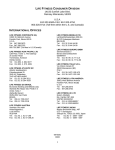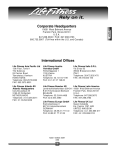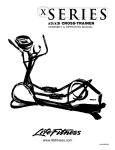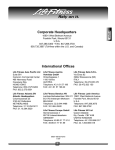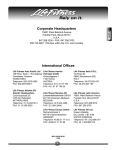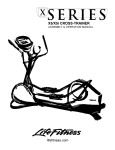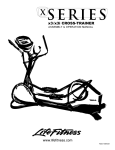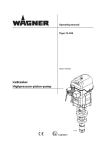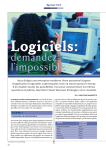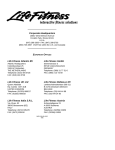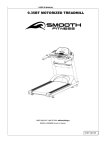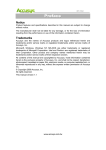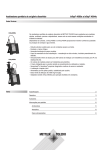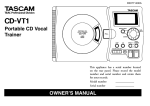Download Owners Manual
Transcript
LIFE F ITNESS CONSUMER DIVISION 14150 Sunfish Lake Blvd. Ramsey Minnesota, 55303-4803 U.S.A. 763.323.4500 FAX: 763.323.4794 800.328.9714 (Toll-free within the U.S. and Canada) W ORLDWIDE O FFICES LIFE FITNESS CORPORATE HQ. 10601 W. Belmont Avenue Franklin Park, Illinois 60131 U.S.A. Tel: 847.288.3675 Fax: 847.288.3762 800.735.3867 (Toll-free in U.S./Canada) LIFE FITNESS ASIA PACIFIC LTD 12th Floor, Tower 1, The Gateway 25 Canton Road Tsimshatsui, Kowloon HONG KONG Tel: 011 852. 2. 891 6677 Fax: 011 852. 2. 575. 6001 LIFE FITNESS ATLANTIC BV Atlantic Headquarters Columbusstraat 25 3165 AC Rotterdam THE NETHERLANDS Tel: 011 31 10 294 5011 Fax: 011 31 10 294 5029 LIFE FITNESS DO BRAZIL Brunswick Bowling and Billiards Ltda. Alameda Rio Negro 433, Predio II 3 Andar, Sala 2 Aphaville Barueri 06454-904 Sao Paulo BRAZIL Tel: 055 11 7295 2217 Fax: 055 11 7295 2218 LIFE FITNESS AUSTRIA Vertriebs Ges.mbH Hintschiggasse 1 1100 Vienna AUSTRIA Tel: 011 43. 1. 61 57 198 Fax: 011 43. 1. 61 57 198.20 LIFE FITNESS BENELUX NV Lambrechtshoekenlaan 309-311 B-2170 Antwerpen-Merksem BELGIUM Tel: 011 32 3 644 44 88 Fax: 011 32 3 644 24 80 LIFE FITNESS EUROPE GMBH Siemensstrasse 3 85716 Unterschleissheim GERMANY Tel: 011 49. 89. 31 77 51.0 Fax: 011 49. 89. 31 77 51.99 LIFE FITNESS ITALIA S.R.L. Via Vittorio Veneto 57 39042 Bressanone (BZ) ITALY Tel: 011 39. 0472. 835 470 Fax: 011 39. 0472. 833 150 LIFE FITNESS LATIN AMERICA 10601 West Belmont Avenue Franklin Park, Illinois 60131 U.S.A. Tel: 847.288.3675 Fax: 847.288.3762 LIFE FITNESS UK LTD Queen Adelaide Ely, Cambs CB7 4UB UNITED KINGDOM Tel: 011 44 1353-666017 Fax: 011 44 1353-666018 LIFE FITNESS JAPAN Nippon Brunswick Bldg., #8F 5-27-7 Sendagaya Shibuya-Ku, Tokyo 151-0051 Japan Tel: 011 81- 3 - 3359 - 4309 Fax: 011 81- 3 - 3359 - 4307 M051-00K20-A213 03/00 1 Before using your Lifecycle exercise bike, it is essential that you read this ENTIRE Operation Manual and ALL Assembly Instructions. It will help you set up your Lifecycle exercise bike quickly and give instructions on how to use it correctly. FCC Warning - Possible Radio / Television Interference NOTE: This equipment has been tested and found to comply with the limits for a Class B digital device, pursuant to part 15 of the FCC rules. These limits are designed to provide reasonable protection against harmful interference in a residential installation. This equipment generates, uses and can radiate radio frequency energy, and if not installed and used in accordance with the instructions, may cause harmful interference to radio communications. However, there is no guarantee that the interference will not occur in a particular installation. If this equipment does cause harmful interference to radio or television reception, which can be determined by turning the equipment off and on, the user is encouraged to try to correct the interference by one or more of the following measures: • Reorient or relocate the receiving antenna. • Increase the separation between the equipment and the receiver. • Connect the equipment into an outlet on a circuit different from that to which the receiver is connected. • Consult the dealer or an experienced radio/TV technician for help. CAUTION: You are cautioned that any changes or modifications to this equipment could void your product warranty! An authorized service representative must perform any service, other than cleaning or user maintenance. There are no user serviceable parts. 2 T ABLE OF CONTENTS Section 1. 1.1 1.2 Description Page Getting Started....................................................................................................... 5 Important Safety Instructions .............................................................................. 5 Set Up .............................................................................................................. 6 ® 1.3 2. 2.1 2.2 3. 3.1 3.2 4. 4.1 4.2 4.3 4.4 5. 5.1 5.2 5.3 5.4 6. 6.1 6.2 How to Stabilize the Lifecycle Exercise Bike How to Adjust the Seat How to Adjust the Footstraps Optional Settings for the Lifecycle Exercise Bike.................................................. 9 Maximum Workout Time English / Metric Conversion The Display Console .............................................................................................. 10 Display Console Overview.................................................................................. 10 Display Console Descriptions ............................................................................. 11 ® Heart Rate Zone Training + Exercise..................................................................... 13 Why Heart Rate Zone Training Exercise?............................................................ 13 Heart Rate Monitoring ........................................................................................ 14 ® The Polar Heart Rate Chest Strap ® The Lifepulse Digital Heart Rate Sensors The Workouts ........................................................................................................ 15 Workout Descriptions………………………………………………………………………15 To Begin a Lifecycle Exercise Bike Workout Quick Start ® Fat Burn and Cardio / Heart Rate Zone Training + Heart Rate Hill and Heart Rate Interval ™ Extreme HR ™ Sport Training Hill Random and Manual Heart Rate Check Points Fit Test Fit Test Tips C7i/R7i-C9i/R9i Lifecycle Exercise Workouts (Chart)............................................ 24 The Race Mode Option...................................................................................... 24 How to Maximize Workouts on the Lifecycle Exercise Bike................................... 25 Selecting the Correct Intensity Level Service and Technical Data .................................................................................... 26 Preventive Maintenance Tips.............................................................................. 26 How to Solve Basic Operating Problems ............................................................. 27 Troubleshooting the Heart Rate Chest Strap........................................................ 27 How to Obtain Product Service........................................................................... 38 Specifications ........................................................................................................ 29 C7i/R7i Lifecycle Exercise Bike Specifications ..................................................... 29 C9i/R9i Lifecycle Exercise Bike Specifications ..................................................... 30 © 2000 Life Fitness, a division of Brunswick Corporation. All rights reserved. Life Fitness, Lifecycle, and Lifepulse are registered trademarks, and Heart Rate Zone Training, and “RELY ON IT” are trademarks of Brunswick Corporation. Any use of these trademarks, without the express written consent of Life Fitness is forbidden. 3 This Operation Manual describes the functions of the following products: Lifecycle exercise bike Models: C7i R7i C9i R9i See “Specifications” page in this manual for product specific features. Statement of Purpose: The Exercise Bike is an exercise machine that enables users to simulate cycling in an upright or recumbent position depending on model configuration. Life Fitness STRONGLY recommends seeing a physician for a complete medical exam before undertaking an exercise program, particularly if the user has a family history of high blood pressure or heart disease, or is over the age of 45, or smokes, has high cholesterol, is obese, or has not exercised regularly in the past year. If, at any time while exercising, you experience faintness, dizziness, pain, or shortness of breath, you must stop immediately. Life Fitness conseille VIVEMENT de consulter un médecin pour suivre un examen médical complet avant de se lancer dans un programme d’exercice. Ceci concerne surtout les utilisateurs avec des antécédents familiaux de tension élevée ou d’affections cardiaques, les personnes de plus de 45 ans, les fumeurs et les obèses, ainsi que tous ceux qui ont un taux élevé de cholestérol ou qui n’ont pas fait d’exercice régulièrement depuis un an. Si, à tout moment pendant l’exercice, l’utilisateur ressent un malaise, un étourdissement ou une douleur, ou s’il se trouve à court de souffle, il doit immédiatement s’arrêter. 4 1. GETTING STARTED 1.1 IMPORTANT SAFETY INSTRUCTIONS • Before using this product, it is essential that you read this ENTIRE operation manual and ALL instructions. The Lifecycle exercise bike is intended for use solely in the manner described in this manual. • Always follow the console instructions for proper operation. • Close supervision is necessary when used by or near children, invalids or disabled persons. • Never operate a Life Fitness exercise bike if it has been dropped, damaged, or even partially immersed in water. Contact Life Fitness Customer Support Services for assistance. • Never insert objects into any opening in your Lifecycle exercise bike. If an object should drop inside, carefully retrieve it. If you cannot reach the item, contact Life Fitness Customer Support Services. • Never place liquids of any type directly on the unit, except in an accessory tray. Containers with lids are recommended. • Do not use the Lifecycle exercise bike outdoors, near swimming pools or in areas of high humidity. • Do not use the Lifecycle exercise bike in areas where aerosol spray products are being used or where oxygen is being administered. Such substances increase the danger of combustion and explosion. • Keep all loose clothing, shoelaces, and towels away from the Lifecycle exercise bike pedals. • Keep the area around your Lifecycle exercise bike clear of any obstructions, including walls and furniture. • Always be careful and exercise caution when mounting or dismounting your Lifecycle exercise bike. Use the handlebar whenever additional stability is required. • Wear shoes with rubber or high-traction soles. Do not use shoes with heels, leather soles, cleats or spikes. Do not use the bike in your bare feet. • Do not tip the Lifecycle exercise bike on its side during operation. CAUTION: Life Fitness STRONGLY recommends that if you are undertaking an exercise program please see your physician for a complete medical exam, particularly if you have a family history of high blood pressure or heart disease, are over the age of 45, or if you smoke, have high cholesterol, are obese, or have not exercised regularly in the past year. If, at any time while exercising, you experience faintness, dizziness, pain, or shortness of breath, you must stop immediately. SAVE THESE INSTRUCTIONS FOR FUTURE REFERENCE 5 1.1 CONSIGNES DE SÉCURITÉ IMPORTANTES • Avant d’utiliser ce produit, lire impérativement ce manuel d’utilisation en ENTIER, ainsi que TOUTES les instructions. Le vélo d’exercice Lifecycle est conçu pour être utilisé uniquement de la manière décrite dans ce manuel. • Les instructions de la console doivent toujours être suivies pour obtenir un fonctionnement correct. • Une surveillance étroite est nécessaire lorsque cet appareil est utilisé en présence d’enfants, d’invalides ou de handicapés, ou par ces personnes. • Ne jamais faire fonctionner de vélo d’exercice Life Fitness qui serait tombé ou aurait été endommagé ou partiellement immergé dans l’eau. Appeler le service clientèle de Life Fitness pour obtenir de l’assistance. • Ne jamais insérer d’objets dans un orifice du vélo d’exercice Lifecycle. Tout objet accidentellement tombé à l’intérieur doit être récupéré. S’il est impossible de l’atteindre, contacter le service clientèle de Life Fitness. • Ne jamais placer de liquides quelconques directement sur l’appareil, sauf dans le plateau pour accessoires. Il est conseillé d’utiliser des conteneurs munis de couvercles. • Ne pas utiliser le vélo d’exercice Lifecycle à l’extérieur, près d’une piscine ou dans des endroits très humides. • Cet appareil ne doit pas être utilisé dans des salles où des vaporisateurs aérosols sont employés ou bien où de l’oxygène est administré. De telles substances augmentent les risques de combustion et d’explosion. • Maintenir les vêtements lâches, les lacets et les serviettes à l’écart des pédales du vélo d’exercice Lifecycle. • Maintenir la zone autour de l’appareil libre de toute obstruction, y compris murs et meubles. • L’utilisateur doit toujours faire attention et procéder avec précaution lorsqu’il monte ou descend d’un vélo d’exercice Lifecycle. Utiliser le guidon afin de ne pas perdre l’équilibre. • Porter des chaussures avec des semelles en caoutchouc ou fournissant une très bonne adhérence. Ne pas utiliser de chaussures à talons, de semelles en cuir ou de crampons. Ne pas utiliser ce vélo pieds nus. • Ne pas renverser le vélo Lifecycle sur le côté pendant son fonctionnement. MISE EN GARDE: Life Fitness conseille VIVEMENT de consulter un médecin pour suivre un examen médical complet avant de se lancer dans un programme d’exercice. Ceci concerne surtout les utilisateurs avec des antécédents familiaux de tension élevée ou d’affections cardiaques, les personnes de plus de 45 ans, les fumeurs et les obèses, ainsi que tous ceux qui ont un taux élevé de cholestérol ou qui n’ont pas fait d’exercice régulièrement depuis un an. Si, à tout moment pendant l’exercice, l’utilisateur ressent un malaise, un étourdissement ou une douleur, ou s’il se trouve à bout de souffle, il doit s’arrêter immédiatement. CONSERVER CES INSTRUCTIONS POUR TOUT USAGE ULTÉRIEUR. 6 1.2 SETUP 1.2.1 HOW TO STABILIZE THE LIFECYLE EXERCISE BIKE Depending on the surface on which you place your Lifecycle exercise bike on, it may need to be leveled. After you place the bike where you will be primarily using it, check the stability of the bike by attempting to rock it back and forth. If it rocks, it isn’t level. To level it, rotate the foot on the stabilizer bar that appears to be higher counterclockwise (as viewed from above) with your finger until the bike is level. Tighten the locknut. FOOT 7 1.2.2 HOW TO ADJUST THE SEAT A properly adjusted seat is extremely important in any bike-oriented exercise activity and the Lifecycle exercise bike is no exception. If the seat is too close, excessive strain will be placed on the knees and quadriceps muscles; if the seat is too far, the resulting reaching action will irritate the feet, ankles, hips and knees. Sit on the seat and place the balls of your feet on the pedals. An optimum position will allow you to move through the bottom of the stroke without locking your knees or shifting in the seat (your knees should have a slight bend at the point of fullest leg extension). UPRIGHT EXERCISE BIKES : If the seat needs to be adjusted, dismount the bike. Pull out the adjusting pin located on the front of the seat post. Slide the seat post up or down as necessary to the proper position and re-insert the pin to complete engagement. Check the seat height again and readjust it if necessary. CAUTION: Do not attempt to adjust the seat while you are pedaling the bike. Doing so or failing to insert the seat pin completely may result in an uncomfortable workout or cause injury. MISE EN GARDE : Ne pas essayer d’ajuster la selle pendant le pédalage. Tout ajustage en cours de fonctionnement ou toute insertion incomplète de la goupille de la selle pourrait nuire à l’exercice ou entraîner des blessures. RECUMBENT EXERCISE BIKES : If the seat needs to be adjusted, lift the spring-loaded adjusting handle located on the right, front side of the seat. Slide the seat forward or backward as necessary to the proper position and release the pin to complete engagement. Gently slide the seat forward and backward a small distance to ensure it is locked into place. Check the seat distance again and re-adjust it if necessary. CAUTION: Do not attempt to adjust the seat while you are pedaling the bike. Doing so or failing to insert the seat pin completely may result in an uncomfortable workout or cause injury. MISE EN GARDE : Ne pas essayer d’ajuster la selle pendant le pédalage. Tout ajustage en cours de fonctionnement ou toute insertion incomplète de la goupille de la selle pourrait nuire à l’exercice ou entraîner des blessures. 8 1.2.3 HOW TO ADJUST THE FOOTSTRAPS The pedals on your Lifecycle exercise bike have footstraps with slits on both the inside and the outside of each strap. To adjust the width of the straps, grasp the outside of the strap and pull down and away from the knob. Once the slotted end is removed, choose a width that will feel the most comfortable while you are riding, reinsert the knob through the slot and pull the strap up. The strap will click when it locks in place. CAUTION: Do not attempt to adjust the pedal footstraps while you are pedaling the bike. Doing so may result in an uncomfortable workout or cause injury. MISE EN GARDE : Ne pas essayer d’ajuster les cale-pieds pendant le pédalage. Cela pourrait nuire à l’exercice ou entraîner des blessures. 9 1.3 OPTIONAL SETTINGS FOR THE LIFECYCLE EXERCISE BIKE 1.3.1 MAXIMUM WORKOUT TIME The Maximum Workout Time Option allows the maximum workout time to be changed from the default maximum time limit of 99 minutes to anywhere from 1 to 99 minutes. Altering the maximum workout time will affect all workouts except the Fit Test. To change the Lifecycle exercise bike maximum workout time, proceed as follows: 1. Press and hold the Down Arrow Key. 2. Begin pedaling (you must reach a minimum of 35 RPM), then press the Start Key. All LED’s and 14-segment displays will be illuminated. This is called Diagnostic State 1. There are fifteen distinct Diagnostic States and the maximum workout time default settings reside in Diagnostic State 6. Each time you press the Enter Key you will advance one diagnostic state. Continue to advance to Diagnostic State 6. 3. When you reach Diagnostic State 6, the current “MAXIMUM DURATION” setting will be displayed. The default maximum workout time is 99 minutes. 4. Use Down Key to decrease the “MAXIMUM DURATION” or the Up Key to increase the “MAXIMUM DURATION”. 5. To exit the Diagnostic States, press the Clear Key repeatedly until you return to the User Display. The User Display is the initial Display Console you see when you approach the unit for normal operation. 1.3.2 ENGLISH / METRIC CONVERSION The factory default is set to English measurement. When you reach Diagnostic State 8 (see above), the Data Entry Window will display ENGLISH to designate English units. To change the default to metric measurement, press the Up/Down Keys and the system will toggle between English and metric units and display METRIC. For more information on the other 13 Diagnostic States, please refer to the Lifecycle Service Manual, available from Life Fitness Customer Support Services. (See How To Obtain Product Service for information on how they can be reached). 10 2 T HE DISPLAY CONSOLE 2.1 DISPLAY CONSOLE OVERVIEW The Lifecycle exercise bike’s Display Console is easy to use, and it allows you to follow your progress as you ride. The on-board computer lets you tailor your workouts to your individual fitness capabilities and goals while providing a unique means of measuring your fitness improvement from one workout to the next. 11 2.2 DISPLAY CONSOLE DESCRIPTIONS A. MESSAGE CENTER: Provides all the instructions for programming the Lifecycle exercise bike. In addition it displays Elapsed Time, Level or Calories, and Speed. Heart Rate, Calories Per Hour, Distance Traveled, Watts, MPH (in Race Mode) are alternately displayed. The alternating display can be locked on any one value by depressing the Display Lock Key. B. START: The Start Key activates the Display Console after you begin pedaling and is then inactive for the remainder of the workout. A F G C B E I H D C. QUICK START: Use this key after pressing the Start Key and immediately begin a Manual Workout. D. THE ARROW keys: Use these keys to select all of your workout parameters, including length of time of your ride, age, weight, gender, target heart rate and effort level. You can also increase or decrease your effort level at any time by pressing either of the Up/Down Keys (or change your target heart rate if you are in the Fat Burn, Cardio, Heart Rate Hill, Heart Rate Interval, or Extreme HR Workouts). E. ENTER: Use this key to execute input of any information which you have keyed. It is not necessary to press Enter when keying in a new effort level. F. DISPLAY LOCK: This key allows you to freeze the Message Center Display on one set of feedback information – Heart Rate, Calories / Hour, Miles (Kilometers), Watts, etc. To unlock the display, simply push the Display Lock Key again. G. CLEAR- Use the Clear Key during programming to clear an erroneous value. Press the key once to end your current workout and show the Workout Summary. Press the key a second time to clear the summary information and the Message Center Window prompts you to choose a workout. PAUSE: Use the Pause Key to put your workout on hold or restart it. To place your workout on hold, press the key once and continue pedaling (remember, you are powering the machine; if you stop pedaling, all power is lost and the display will go blank). Pedal resistance drops to the minimum when the Lifecycle exercise bike is paused; the stopwatch function is activated and the Elapsed Time Window begins counting up from zero. Use this as a brief rest period if you feel fatigued or to take your heart rate. H. RACE ON / OFF: Lets you toggle in and out of the Race Mode at any time in the Hill, Random and Manual Workouts. The Speed / RPM display will toggle between RPM and MPH / KPH every five seconds. Your MPH will be dependent on your pedal speed and the level chosen. (See the Race Option information). 12 I. WORKOUT PROFILE WINDOW: Displays a matrix of lights showing your present position and upcoming terrain. The higher the column of lights the greater the resistance. The left-most column of lights represents your current position. The remaining columns show the upcoming terrain. As your workout progresses, the lights move across the screen from right to left. In the Fat Burn, Cardio, Heart Rate Hill, Heart Rate Interval, and Extreme HR Workouts, a heart shape (?) will be displayed in the window when you are required to grasp the Lifepulse sensors (C9i/R9i models), and indicating that your heart rate is needed. A flashing heart will also appear at the conclusion of the Fit Test. The heart rate will be read automatically on telemetry equipped models (C7i/R7i) when wearing a heart rate chest strap. 13 3 HEART RATE ZONE T RAINING + EXERCISE 3.1 WHY HEART RATE ZONE TRAINING EXERCISE? Research shows that exercising within a specific heart rate range is the optimal way to monitor exercise intensity and achieve maximum results. That is the idea behind the Life Fitness Heart Rate Zone Training+ Exercise Program. Zone Training takes the guesswork out of working out by identifying specific ranges, or zones, in which to maintain a heart rate to achieve maximum exercise results according to personal goals. In short, Zone Training all but eliminates under- and over-training by allowing you to target your heart rate to your individual fitness objectives. For instance, if the primary goal is to burn fat, exercise at a level between 60% and 75% of your theoretical † maximum heart rate . To improve your cardiovascular condition, you should work out at 75% to 85% of your theoretical maximum heart rate. Life Fitness offers five exclusive workouts designed to take full advantage of the benefits of Heart Rate Zone Training: Fat Burn, Cardio, Heart Rate Hill, Heart Rate Interval, and Extreme HR. Vary the focus of the exercise activities by entering a new target heart rate with the Arrow Keys. These 5 workouts measure heart rate. As you exercise, grasp the Lifepulse sensors when prompted (models C9i or R9i), or simply wear a heart rate chest strap on telemetry equipped models (C7i and R7i) and your heart rate will be transmitted to the on-board computer. The resistance level will automatically adjust to maintain the target heart rate based on your actual heart rate. 178 157 136 115 170 150 130 110 161 142 123 104 153 135 117 99 144 127 110 93 136 120 104 88 127 112 97 82 119 105 91 77 110 97 84 71 102 % 90 % 78 % 66 % † Defined by the American College of Sports Medicine’s “Guidelines for Exercise Testing and Prescription” as 220 minus your age. 14 3.2 HEART RATE MONITORING 3.2.1 THE POLAR® HEART RATE CHEST STRAP (MODELS C7i and R7i) Wet the electrodes (A) to the transmitter (the two grooved surfaces on the underside of the strap) and secure the strap as high under the chest muscles as possible. The strap should be snug, but comfortable enough to allow for normal breathing. The transmitter strap will deliver an optimum heart rate reading when the electrodes are directly in contact with bare skin. However, it will function properly through wet, lightweight clothing. The key to proper operation is for the electrodes to remain wet to conduct the electrical impulses of the heart back to the receiver. If it becomes necessary to remoisten the chest strap transmitter, grasp the center of the strap, pull it away from the chest to expose the two electrodes, then moisten them in this position. 3.2.2 THE LIFEPULSE® DIGITAL HEART RATE SENSORS (MODELS C9i and R9i) The patented Lifepulse Digital Heart Rate Sensors are the built-in heart rate monitoring system on the Lifecycle C9i/R9i exercise bike. To use the Lifepulse sensors, simply grasp the stainless steel sensors on the handlebars when the Display Console prompts you with the (?), or anytime you wish to check your heart rate. There are four sensors, two on each arm. You must make contact with all four to obtain your heart rate. The console will display your heart rate in 10 to 40 seconds, depending on the individual. 15 4 T HE WORKOUTS 4.1 WORKOUT DESCRIPTIONS Selecting a workout on your Life Fitness exercise bike is easy. Ten computerized aerobic workouts, including the exclusive Fat Burn, Cardio, and Fit Test workouts, are preprogrammed on your Lifecycle exercise bike: 4.1.1 TO BEGIN A LIFECYCLE EXERCISE BIKE WORKOUT Use the following steps to begin any of the Lifecycle workouts. • First adjust the seat position and make certain the seat pin is properly locked and the bike is level. • Begin pedaling and press the Start Key. • Select a workout by pressing the Up/Down Keys until the workout you want appears in the Message Center and then press Enter (or wait 10 seconds and your selection will be automatically entered). Your Lifecycle exercise bike features graduated levels of intensity to more closely simulate riding through hills and valleys. As you encounter hills in various workouts, the pedal resistance will increase or decrease for the duration of that hill. The Lifecycle exercise bike is a "constant work" machine; in the Sport Training, Hill, Race, Random, and Manual Workout, pedal resistance automatically compensates for changes in RPM. In other words, the slower you pedal, the greater the resistance; conversely, the faster you pedal the less resistance you feel.* The distance you travel will remain the same; pedaling faster will not bring you to the end of a workout sooner nor burn more calories, assuring you of a consistent workout. NOTE: Mileage readings are arbitrary and should not be used to compare workouts. Total calories burned is the best measure of the amount of work performed in any given workout. 4.1.2 QUICK START The fastest way to begin exercising, allows you to immediately start a Manual Workout. You can “Quick Start” a Manual Workout without selecting a workout. To do so, just begin pedaling, press Start. Then press the “Quick Start” Key. † REMEMBER: You can change levels at any time during your workout by simply keying in a new level using the Arrow Keys! 4.1.3 FAT BURN AND CARDIO/H EART RATE ZONE TRAINING® + WORKOUTS • Begin a Lifecyle workout (see beginning of this section). • Enter your age using the Up/Down Keys to receive your computed Target Heart Rate. Press Enter to accept the calculated target or input your own target heart rate using the Up/Down Keys, and press Enter. • The Message Center will prompt you to enter a time from 1–99 minutes (or the maximum time preprogrammed on unit). Key in the time you want your workout to last and press Enter. • Finally, select a warm-up effort level from 1 – 20. The effort level will be displayed in the Data Entry Window (you do not need to press Enter) and your heart rate management workout will begin a three minute warm-up at this level or until you reach your Target Heart Rate, whichever comes first, followed by the actual heart rate controlled portion of the workout. *This is true as long as you pedal faster than 65 RPM, the resistance will drop off to the point where you can continue pedaling at a pace sufficient to maintain power to the console. † Except in the Heart Rate controlled workouts, in which you may change your Target Heart Rate. 16 FAT B URN WORKOUT The Fat Burn and Cardio heart rate workouts adjust the resistance of the Lifecycle exercise bikes in response to your heart rate. These two workouts use either the technology of the Lifepulse Digital Sensors (models C9i and ® R9i) or Polar compatible telemetry (models C7i and R7i ) to monitor your heart rate and automatically adjust the work load to maintain your Target Heart Rate. The end result is a perfect workout every time, eliminating both under- and over-training. On the Lifecycle exercise bike, the Fat Burn Workout will maintain your heart rate at 65% of your theoretical † maximum heart rate or another target heart rate that you enter. Pedal resistance will automatically adjust to maintain the target heart rate. Exercising at 65% of your theoretical maximum heart rate maximizes the aerobic benefits of exercise by accessing the body’s fat stores for fuel and by allowing you to exercise longer. CARDIO WORKOUT The Cardio Workout is virtually identical to the Fat Burn Workout. The only difference is that your target heart rate is calculated at 80% of your theoretical maximum to accentuate cardiovascular improvement by placing a heavier workload on the heart muscle. If you wish to vary the focus of your exercise activities (once the warm-up is complete), you may switch back and forth between the Fat Burn and Cardio Workouts at any time during a workout by simply pressing the Enter Key- creating the ultimate interval training workout! Remember, you may change your Target Heart Rate at any time after the warm-up period by simply pressing the Up/Down Keys or toggling Fat Burn and Cardio target heart rates using the Enter Key. The Life Fitness Heart Rate Zone Training workouts begin with a three-minute warm-up period designed to safely get you closer to your target heart rate from a resting start. It should take two to three minutes for your heart rate to reach your target. NOTE: If your heart rate is above the chosen target during the warm-up period, the warm-up period will immediately end and the Lifecycle exercise bike will begin automatically varying its resistance to maintain your target heart rate. † Defined by the American College of Sports Medicine’s “Guidelines for Exercise Testing and Prescription” as 220 minus your age. 17 4.1.4 HEART RATE HILL AND HEART RATE INTERVAL WORKOUTS These workouts combine both the standard Hill workout profiles with the Fat Burn and Cardio workout profiles. You are asked to enter your age as in standard Fat Burn and Cardio Heart Rate Workouts. A recommended workout Heart Rate is then calculated for you. You are shown this value and asked to accept or change it using the Arrow Keys and/or Enter Key. This value is used as the upper value of your workout zone. The lower values of this zone are automatically calculated based on which program you selected. During the workout your Heart Rate Zone is tracked to see how long you stay in your zone. If your heart rate reaches or goes past the Theoretical Maximum for more then 45 seconds, the unit will automatically drop into PAUSE mode. HEART RATE HILL WORKOUT HEART RATE HILL takes you through 3 intensity levels based on your target heart rate. This workout is similar to the standard heart rate program, except your Target Heart Rate goal varies. If you reach the first heart rate goal, then a new goal is set. This workout consists of 3 hills based on 3 heart rate goals: Hill #1 is 90% Target Heart Rate (THR). Hill #2 is 95% THR. Hill #3 is THR. The valley will always be defined as 85% of the THR. The time, or duration you spend at a given heart rate goal is fixed at 1 minute once you reach your goal. If you don’t reach the given goal, you won’t encounter any other goals. Your fitness level determines the number of hills and valleys you encounter. Workout duration is based on time and thus can end during any Target Heart Rate goal. 18 HEART RATE INTERVAL WORKOUT HEART RATE INTERVAL Workout toggles you through 2 intensity levels based on your target heart rate. Duration of the hills and valleys is 3 minutes each, after you reach your current goal. Your fitness level determines the number of hills and valleys you encounter. 4.1.5 EXTREME HR WORKOUT EXTREME HR Workout is an intense workout for more experienced users. This workout is used to add variety to your workout and break through plateaus. This workout raises and lowers your heart rate between two different goals. The objective is to get your heart rate up and down as quickly as possible, and is similar to running sprints. Begin with a standard 3-minute warm up. After warm-up, the resistance is increased until the heart rate reaches Target Heart Rate (THR). Your heart rate is maintained at THR for a stabilizing period. Then the resistance is reduced. When your heart rate recovers to 75% THR, it is maintained at 75%THR for a stabilizing period. Then, the bike increases resistance again. This will keep happening until your workout duration is reached. 19 4.1.6 SPORT TRAINING WORKOUT SPORT TRAINING Workout simulates conditions that a biker would experience when cycling in an outdoor environment. Baseline level is hill #3, which simulates flat biking in an outdoor environment. Hill #1 simulates going downhill in an outdoor environment. Inclines last 30 to 60 seconds. 4.1.7 HILL WORKOUT HILL is an interval-training workout consisting of a warm-up period followed by a plateau of constant effort, progressively more difficult levels of effort (hills) separated by periods of recovery (valleys) and a cool-down period. The Lifecycle exercise bike’s patented Hill Workout offers the ideal configuration for interval training: periods of intense aerobic activity separated by regular intervals of lower-intensity exercise. Interval training programs have been scientifically demonstrated to yield greater cardiorespiratory improvement than steady-pace training. Not only does the Hill Workout offer the challenge of alternating periods of high and low intensity, but the levels of intensity become progressively more difficult during the course of the workout. Because you have the option of working out in a Hill Workout for anywhere from 1 to 99 minutes, and because the Hill Workout is composed of four distinct phases, the workout must be structured differently to accommodate the entire array of workout durations. Longer workouts add more hills. The Hill diagram below shows the effort level and recovery periods encountered during a Hill Workout. Effort and recovery periods are simulated on the Display Console by columns of lights in the Program Profile Window. The columns move from right to left during the workout. The higher the column, the higher the incline; consequently, you must increase the effort. TERRAIN (HILLS AND VALLEYS) WARM-UP PLATEAU INTERVAL TRAINING FIRST HR CHECK POINT COOL-DOWN SECOND HR CHECK POINT Each Hill Workout session comprises the following phases: (1) Warm-up, (2) Plateau, (3) Interval Training, and (4) Cool-down. • Warm-up: Gradually brings your heart rate into the lower portion of your Target Heart Rate Zone, increasing respiration and blood flow to working muscles. • Plateau: Brings your heart rate into your target zone. Check your heart rate at the end of the plateau period to ensure that you have entered your Target Heart Rate Zone. • Interval Training: A series of hills and valleys. During this portion of your workout, you will be confronted with sets of four successively steeper hills, each separated from the next by a valley, or recovery period. Check your heart rate at the end of the interval-training period to ensure that you have stayed within your target zone. • Cool-down: The cool-down allows your body to begin removing accumulated by-products of exercise, such as lactic acid, which build up in muscles during your workout and contribute to muscle soreness. 20 4.1.8 RANDOM AND MANUAL WORKOUTS RANDOM WORKOUT RANDOM is a workout of varying effort levels which occur randomly with each exercise session, resulting in more than one million workout combinations. The computer randomly selects hill and valley terrain, which varies with each and every workout, resulting in those more than one million combinations. Because resistance levels are greater in this program than in the Hill Workout, it is recommended that the Random Workout be set one or two levels lower than the level of intensity you would normally select on the Hill Workout. M ANUAL WORKOUT MANUAL maintains a constant effort level based on the goals selected. The Manual Workout provides steady-pace exercise equal to that of the highest hill encountered on the Hill Workout at the same level of effort. Because of the greater resistance levels of this workout, it is recommended that you set the Manual Workout lower than the level of effort that you would normally select on the Hill Workout. You can design your own interval-training workout using the Manual Workout by varying the level of effort during the course of your workout. To do so, select a high level of resistance until you reach the upper end of your Target Heart Rate Zone, then ride at a lower effort level until your heart rate drops to the bottom of your target zone. Then increase the level of effort again until you are back to the upper portion of your target zone. By repeating this process, you will actually be creating your own hills and valleys. 4.1.9 HEART RATE CHECK POINTS For Fat Burning: ü First Heart Rate Check Point — Your heart rate should be between 60% and 70% of the theoretical maximum heart rate for your age category. ü Second Heart Rate Check Point — Your heart rate should be between 70% and 75% of the theoretical maximum heart rate for your age category. For Cardio: ü First Heart Rate Check Point — Your heart rate should be between 75% and 80% of the theoretical maximum for your age category. ü Second Heart Rate Check Point — Your heart rate should be between 80% and 85% of the theoretical maximum for your age category. Be sure to check your heart rate near the end of the plateau and interval training periods. If you are not wearing a heart rate chest strap (models C7i and R7i), see Hill diagram above. You should always take your heart rate at the time indicated to make sure you are staying within your target heart rate zone. 21 4.1.10 FIT TEST WORKOUT The Lifecycle Exercise Bike Fit Test Workout is another exclusive feature of this versatile exercise bike. Your Fit Test score is also an approximate measure of your VO2 max; think of it as your relative fitness score. Use the Fit Test to monitor improvement in your endurance every four to six weeks. • After selecting the Fit Test Workout using the Up/Down Keys, the Message Center will ask for your age (ENTER AGE). Use the Up/Down Keys to input your age and press Enter Key. • After entering your age, you will be asked for your weight (SELECT WEIGHT). Use the Up/Down Keys to input your weight and press Enter Key. • After entering your weight, the Message Center will prompt you to select your gender (SELECT GENDER). Press the Up/Down Keys to do so, up for male or down for female and then press Enter Key. • After selecting a gender the Message Center will prompt you to select a workout level (SELECT LEVEL). Consult the Activity Levels chart on the following page for the effort level you should input based on your age, gender, and activity level. Use the Up/Down Keys to enter the corresponding level. After having completed the five-minute Fit Test, you will be prompted to grasp the LifePulse Sensors (C9i/R9i models), or your heart rate will be automatically entered from your heart rate chest strap by the on-board computer (C7i/R7i models). To enter heart rate manually, use the Time prompt to take your pulse and enter it with the Up/Down Keys. The Fit Test score will be displayed, which you can use to find your ranking in the Fit Test scoring tables located in this section. NOTE: Mileage readings are arbitrary and should not be used to compare workouts in different programs. Total calories burned is the best measure of the amount of work performed in any given workout. RECOMMENDED FIT TEST LEVELS AGE WEIGHT (KG) INACTIVE ACTIVE VERY ACTIVE <30 <130 131 - 169 <59 59,5 – 76,8 3 7 7 8 8 12 170 - 210 >210 72,3 – 95,5 >95,5 8 12 12 15 15 16 <130 <59 2 3 7 131 - 169 170 - 210 >210 59,5 – 76,8 72,3 – 95,5 >95,5 3 7 8 7 8 12 8 12 15 <130 131 - 169 170 - 210 <59 59,5 – 76,8 72,3 – 95,5 2 3 3 2 3 7 3 7 8 >210 >95,5 7 8 12 <130 131 - 169 <59 59,5 – 76,8 2 2 2 3 2 3 170 - 210 >210 72,3 – 95,5 >95,5 3 3 3 7 7 8 30-39 40-49 50+ NOTE: If your weight varies from these values substantially, you may wish to increase or decrease the indicated levels accordingly. If your heart rate is below 65% of your theoretical maximum heart rate at the conclusion of the Fit Test, retake the test at a higher level. The Fit Test is an estimate of your VO2 max, which is a measurement of how well the heart supplies oxygenated blood to the exercising muscles and how efficiently those muscles receive oxygen from the blood. This measurement is generally regarded by physicians and exercise physiologists as the standard for aerobic capacity. 22 4.1.11 FIT TEST TIPS The computer will not accept: • Heart rates less than 90 or greater than 199 beats per minute • Body weights less than 74 pounds (34 kg) or greater than 350 pounds (159 kg) • Ages below 10 or over 99 years • Data input that exceeds human potential If you make an error when entering any Fit Test data, you can correct it by pressing Clear, inputting the correct information, and pressing Enter. It is important to take the Fit Test under similar circumstances each time. The heart rate is dependent on many factors, including: • Amount of sleep the previous night (at least seven hours is recommended) • Time of day • Time since last meal (two to four hours after the last meal is recommended) • Time since last drinking a liquid containing caffeine or alcohol, or smoking a cigarette (at least four hours is recommended) • Time since having last exercised (at least six hours is recommended) For the most accurate Fit Test results, you should perform the Fit Test on three consecutive days and average the three scores. NOTE: To receive a proper Fit Test score, you must work within your training heart rate zone, which is 60% to 85% of your theoretical maximum heart rate. REMARQUE : Pour recevoir un score approprié au test d’exercice, il faut rester dans la zone de rythme cardiaque d’entraînement, comprise entre 60 et 85 % du rythme cardiaque maximum théorique. 23 RELATIVE FITNESS CLASSIFICATION FOR MEN AGE Rating 20 - 29 30 - 39 40 - 49 50 - 59 60+ 55+ 52+ 50+ 48+ 45+ Excellent 50 - 54 47 - 51 45 - 49 43 - 47 40 - 44 Good 45 - 49 42 - 46 40 - 44 38 - 42 35 - 39 Above Average 40 - 44 37 - 41 35 - 39 33 - 37 30 - 34 Average 36 - 39 33 - 36 31 - 34 29 - 32 26 - 29 Below Average 31 - 35 28 - 32 26 - 30 24 - 28 21 - 25 Poor 26 - 30 23 - 27 20 - 25 18 - 23 16 - 20 <26 <23 <20 <18 <16 Elite Very Poor RELATIVE FITNESS CLASSIFICATION FOR WOMEN AGE Rating 20 - 29 30 - 39 40 - 49 50 - 59 60+ 49+ 46+ 44+ 42+ 40+ Excellent 44 - 48 41 - 45 39 - 43 37 - 41 35 - 39 Good 39 - 43 36 - 40 34 - 38 32 - 36 30 - 34 Above Average 34 - 38 31 - 35 29 - 33 27 - 31 25 - 29 Average 30 - 33 27 - 30 25 - 28 23 - 26 21 - 24 Below Average 25 - 29 22 - 26 20 - 24 18 - 22 16 - 20 Poor 20 - 24 17 - 21 15 - 19 13 - 17 11 - 15 <20 <17 <15 <13 <11 Elite Very Poor 24 4.2 C7i/R7i AND C9i/R9i LIFECYCLE EXERCISE WORKOUTS (CHART ) Use the Up/Down Keys to scroll through the WORKOUTS, enter GOALS and VALUES, or to choose a HEART RATE. NOTE: You can change your LEVEL and HEART RATE at any time during a workout (except FIT TEST). ™ QUICK START Press Start, press “ Quick Start” SPORT TRAINING Enter time Enter level FAT BURN Enter age Enter Target Heart Rate† Enter time Enter level CARDIO Enter age Enter Target Heart Rate† Enter time Enter level HEART RATE HILL Enter age Enter Max Target Heart Rate† Enter time Enter level HILL Enter time Enter level HEART RATE INTERVAL Enter age Enter Max Target Heart Rate† Enter time Enter level FIT TEST Enter age Enter weight Enter sex Enter level RANDOM Enter time Enter level MANUAL Enter time Enter level ™ EXTREME HR Enter age Enter Max Target Heart Rate† Enter time Enter level † Or accept calculated value shown 4.3 THE RACE MODE OPTION Formerly a workout in and of itself, the Race Mode allows you to vary your pedal resistance to simulate the feel of an actual 20-speed racing bike in the Hill, Random, and Manual Workouts. Turn the Race mode on at any time and the Lifecycle exercise bike’s 20 effort levels are transformed into the “gears” of a high performance road racing bicycle! The pedal resistance will change with the speed at which you pedal, enhancing your workout enjoyment while also allowing you greater control over the workout’s intensity (the greater the resistance, the more LED’s will be illuminated). The distance you travel and the calories you burn during your workout will also vary with your pedal speed. 25 4.4 HOW T O M AXIMIZE WORKOUTS ON THE LIFECYCLE EXERCISE BIKE In the Lifecycle exercise bike’s Manual, Random, and Hill Workouts, you can change the level of intensity at any time by simply pressing the Up/Down Keys. In addition, should you decide to choose a different workout after starting another, simply push the Clear Key twice to clear the first workout and then select the new workout. 4.4.1 SELECTING THE CORRECT INTENSITY LEVEL The Lifecycle exercise bike offers 20 levels of intensity, or difficulty, from which to choose. Level 1 is the easiest and level 20 is the most challenging. Select a low effort level until you become accustomed to the Lifecycle exercise bike, then increase the intensity as your condition improves. The Random and Manual Workouts are proportionately more difficult than the Hill Workout. Because of this, you should be careful to select an effort level in the Random Workout that is one to two levels lower than you would normally select in the Hill Workout. Conversely, if you choose the Manual Workout, you should select an intensity level that is at least three levels lower than the level you would normally work out at in the Hill Workout. The following table will allow you to compare the relative intensities of the four Lifecycle exercise bike computerized fitness workouts. HILL RANDOM MANUAL OR FIT TEST 1 1 1 3 3 2 7 5-7 3 10 8 5 13 12-13 7 17 15 8 18-20 17-18 10 20 12 13 15 17 18 20 26 5 SERVICE AND T ECHNICAL DATA 5.1 PREVENTIVE M AINTENANCE T IPS Your Lifecycle exercise bike is backed by the engineering excellence of Life Fitness and is one of the most reliable, rugged and trouble-free pieces of exercise equipment on the market today. Commercial Life Fitness exercise bikes are among the most popular of aerobic trainers, regularly standing up to marathon use — 18 hours a day, 7 days a week — in health clubs, colleges and military facilities the world over. This same technology, engineering expertise, and reliability has gone into the Life Fitness Exercise Bike. Here are some preventive maintenance tips that will keep your Lifecycle exercise bike operating at peak performance: • Locate your Lifecycle exercise bike in a cool, dry place. • Clean the seat surface regularly. • Clean the seat extrusion with a soft cloth and a non-abrasive liquid cleanser; and check the seat adjustment pin insertion monthly. • Keep the Display Console free of fingerprints and salt build-up caused by sweat. Use a 100% cotton cloth lightly moistened with water and a mild liquid detergent (other fabrics or paper towels may scratch the surface). • Long fingernails may scratch the surface of the console. Use the pad of your fingertip to press the console keys. NOTE: NEVER remove the stabilizer bar. When cleaning the exterior of the unit, a non-abrasive cleanser and soft cotton cloth are strongly recommended. At no time should cleanser be applied directly to any part of the equipment; use non-abrasive cleanser on a soft cloth and then wipe the unit. CAUTION: DO NOT step on any portion of the housing when getting on or off the exercise bike; doing so may crack the housing. The correct way to get on (mount) the recumbent Lifecycle exercise bike is to step over and straddle the housing, then lower yourself onto the seat. Reverse the procedure to get off (dismount). MISE EN GARDE: NE PAS marcher sur le cadre lors de la montée sur le vélo d’exercice ou lors de la descente, car cela risquerait de le fendre. Pour monter correctement sur le vélo d’exercice allongé Lifecycle, il convient d’enjamber le cadre, puis de s’asseoir sur le siège. Procéder à l’inverse pour en descendre. 27 5.2 HOW T O SOLVE BASIC OPERATING PROBLEMS SYMPTOM No Power PROBABLE CAUSE CORRECTIVE ACTION 9-volt battery missing Install 9-volt alkaline battery 9-volt battery too low Replace 9-volt alkaline battery Harness not connected Disconnect and reconnect harness Difficult to pedal 10 to 15 hour break-in period not complete Ride the bike for 10 to 15 hours Bike shuts off during ride Pedaling too slow Pedal at 35 rpm minimum Not entering desired workout duration Check that desired workout duration appears in display window prior to pressing Enter Wire harness connector loose Carefully remove console and disconnect then reconnect the 10pin connector Display flickers or fades in and out 5.3 TROUBLESHOOTING THE HEART RATE CHEST STRAP (MODELS C7i and R7i) The Heart Rate Chest Strap is required when using either the C7i or R7i model, which is equipped with Polar compatible telemetry heart rate monitoring technology. THE HEART RATE READING IS ERRATIC OR ABSENT ENTIRELY: • Repeat the electrode wetting procedure (see How to Use the Optional Heart Rate Chest Strap). The electrodes must be wet to pick up and transmit accurate heart rate readings. • Make sure the electrodes are flat against the skin. • Wash the belt transmitter regularly with mild soap and water. • Make sure the chest strap transmitter is within three feet (one meter) of the heart rate receiver. • The estimated battery life of the chest strap transmitter is 2500 hours of use. If the chest strap transmitter battery is depleted, contact Life Fitness Customer Support Services for instructions on how to have your chest strap replaced. (See “How to Obtain Product Service,” for locations). THE HEART RATE READING IS ERRATIC OR EXTREMELY HIGH (ABOVE 200): • When exercising with the Heart Rate Chest Strap, it may come within range of electromagnetic signals strong enough to cause abnormally elevated heart rate readings. Possible sources of such signals include television sets and/or antennas, computers, cars, high voltage power lines and motor driven equipment. Another heart rate transmitter within three feet (one meter) may also cause abnormal heart rate readings. NOTE: There is a very small – less than one percent – portion of the general population whose heart rates can not be detected by heart rate monitors, including Electrocardiograph. This phenomenon is called biopotential and is extremely rare. 28 5.4 HOW T O OBTAIN PRODUCT SERVICE 1 Verify the symptom and review the operating instructions and How To Solve Basic Operating Problems within this manual. The problem may be unfamiliarity with the Lifecycle exercise bike's features and programs. 2 Locate and document the serial number of the unit, which is located on the underside of the bike, just behind the front stabilizer bar. 3 Contact the nearest Life Fitness Customer Support Services Group: TOLL -FREE WITHIN THE U.S. AND CANADA Telephone: 800.328.9714 Telephone: 612.323.4500 FAX: 612.323.4794 For Product Service Internationally: LIFE F ITNESS EUROPE G MBH Telephone: (+49). 89. 31 77 51.0 FAX: (+49). 89. 31 77 51.38 LIFE F ITNESS (UK) LTD Telephone: (+44) 1353-665507 FAX: (+44) 1353-666719 LIFE F ITNESS B ENELUX Telephone: (+32) 3 644 44 88 FAX: (+32) 3 644 24 80 LIFE F ITNESS ITALIA S.R.L. Telephone: (+39). 0472. 835 470 FAX: (+39). 0472. 833 150 Life Fitness Austria Vertriebs GmbH Telephone: (+43). 1. 61 57 198 FAX: (+43). 1. 61 57 198. 20 LIFE F ITNESS ASIA PACIFIC LTD Telephone: 852. 2575.6262 FAX: 852. 2. 575. 6001 LIFE F ITNESS LATIN A MERICA Telephone: (+1).847.288.3675 FAX: (+1).847.288.3762 LIFE F ITNESS BRAZIL Telephone: 055 11 7266 5210 FAX: 055 11 7295 2218 LIFE F ITNESS R OTTERDAM Telephone: 31 10 294 5011 FAX: 3110 294 5029 LIFE F ITNESS JAPAN Telephone: 81-3 - 3359 - 4309 FAX: 81- 3 - 3359 - 4306 29 6.0 SPECIFICATIONS 6.1 C7i/R7i LIFECYCLE EXERCISE BIKE SPECIFICATIONS Designed use: Consumer Maximum user weight: R7i: 350 pounds / 159 kilograms C7i: 250 pounds / 114 kilograms Power requirements: None Workouts: Quick Start, Fat Burn, Cardio, Heart Rate Hill, Heart Rate Interval, Extreme HR, Sport Training, Hill, Random, Manual, and Fit Test Console displays: Elapsed Time, Pedal RPM and MPH or KPH (Race Mode), Calories Per Hour, Watts and/or METS, Total Calories Burned, Distance Traveled (miles or kilometers), Resistance Level, and Heart Rate (when wearing a telemetry heart rate monitoring chest strap) Heart rate monitor system: Polar compatible telemetry heart rate monitoring system (with Heart Rate Chest Strap) Color: Dark Grey with Black Accents PHYSICAL DIMENSIONS: Length: Width: Height: Weight: C7i inches / 116.8 centimeters inches / 58.4 centimeters inches / 139.7 centimeters pounds / 39,4 kilograms R7i 56 inches / 142.2 centimeters 25 inches / 63 centimeters 48 inches / 121.9 centimeters 121 pounds / 54,8 kilograms C7i 46 inches / 116.8 centimeters 23 inches / 58.4 centimeters 37 inches / 94 centimeters 105 pounds / 47,6 kilograms R7i 55 inches / 139.7 centimeters 28 inches / 71.1 centimeters 41 inches / 104.1 centimeters 159 pounds / 72 kilograms 46 23 55 87 SHIPPING DIMENSIONS: Length: Width: Height: Weight: 30 6.2 C9i/R9i LIFECYCLE EXERCISE BIKE SPECIFICATIONS Designed use: Consumer Maximum user weight: R9i: 350 pounds / 159 kilograms C9i: 250 pounds / 114 kilograms Power requirements: None Workouts: Quick Start, Fat Burn, Cardio, Heart Rate Hill, Heart Rate Interval, Extreme HR, Sport Training, Hill, Random, Manual, and Fit Test Console displays: Effort Level, MPH or KPH (Race Mode), Total Calories Burned, Distance Traveled (miles or kilometers), Elapsed Time, Heart Rate, Pedal RPM, Calories Per Hour, and Watts and/or METS Heart rate monitor system: Lifepulse Digital Heart Rate Sensors Color: Dark Grey with Black Accents PHYSICAL DIMENSIONS: Length: Width: Height: Weight: C9i: inches / 116.8 centimeters inches / 58.4 centimeters inches / 139.7 centimeters pounds / 39.4 kilograms R9i: 56 inches / 142.2 centimeters 25 inches / 63 centimeters 48 inches / 121.9 centimeters 121 pounds / 54.8 kilograms C9i: 46 inches / 116.8 centimeters 23 inches / 58.4 centimeters 37 inches / 94 centimeters 105 pounds / 47.6 kilograms R9i: 55 inches / 139.7 centimeters 28 inches / 71.1 centimeters 41 inches / 104.1 centimeters 159 pounds / 72 kilograms 46 23 55 87 SHIPPING DIMENSIONS: Length: Width: Height: Weight: 31































